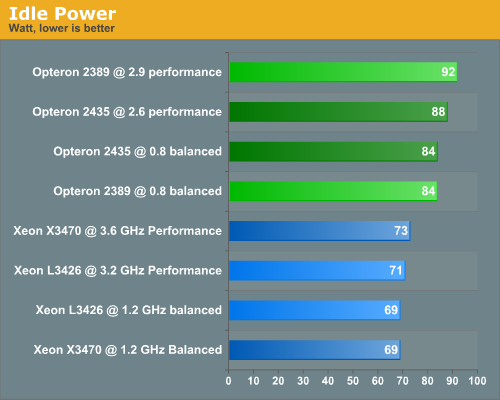Dynamic Power Management: A Quantitative Approach
by Johan De Gelas on January 18, 2010 2:00 AM EST- Posted in
- IT Computing
Our Benchmark Choice
For this article we chose Fritzmark 4.2, the chess benchmark designed by Mathias Feist. The benchmark has the disadvantage that it is not real world for most IT professionals, but it allows us to control the number of threads very easily and precisely. It is also a completely integer dominated benchmark which runs completely in the CPU caches. This allows us to isolate the CPU power savings and the performance and power measurements will still have some resemblance to the typical server loads. This is in contrast to an FP intensive benchmark like LINPACK.
Software Power Management: Windows 2008 Power Plans
On our 64-bit Windows Server 2008 R2 Enterprise two power plans are available:

The interesting thing is how the power plan affects the processor power management (PPM). With Balanced, Turbo Boost never came into action. The L3426 was stuck at 1.86GHz and the X3470 never clocked higher than 2.93GHz. When running idle, both CPUs stayed at 1.2GHz (9x multiplier). The Opterons scaled back to 0.8GHz.
Once set at the Performance power plan, the CPUs never scaled below the default clock speed. According to most clock speed utilities, the Xeons always tried to achieve the highest possible Turbo Boost clock speed. The L3426 switched between 3.066 and 3.2GHz. Note that this did not increase the power consumption significantly: it only used 2W extra on the L3426. The Opterons ran at their top speed. To measure the effect of the power plans we measured the power consumption of the different servers running idle in Windows 2008 R2. This is the power consumption of the complete system, measured at the electrical outlet minus the fans.

We focus on a comparison between the green and blue bars. Comparing the CPUs on each platform offers some interesting insights. Let's first check out the AMD Platform. The Opteron 2389 "Shanghai" clearly needs a higher voltage to achieve 2.9GHz (1.15 - 1.325 V). Despite the fact that the six-core has two cores more to power, the six-core Opteron needs 4W less than the 2.9GHz quad-core Opteron. The reason is that the 2.6GHz never needs more than 1.3V (min: 1.075V) and is also making very good use of clock gating with cache dump (a.k.a. "Smart Fetch").
The idle power measurement of the Xeons shows us how little power is saved by scaling back the frequency: only 2W. The power savings are a result of fine-grained clock gating and core power gating.










35 Comments
View All Comments
n0nsense - Monday, January 18, 2010 - link
Here is what system sees ...only one is 2.5, other three are 2.0 :)
nons ~ # cat /proc/cpuinfo
processor : 0
vendor_id : GenuineIntel
cpu family : 6
model : 23
model name : Intel(R) Core(TM)2 Quad CPU Q9300 @ 2.50GHz
stepping : 7
cpu MHz : 2497.000
cache size : 3072 KB
physical id : 0
siblings : 4
core id : 0
cpu cores : 4
apicid : 0
initial apicid : 0
fpu : yes
fpu_exception : yes
cpuid level : 10
wp : yes
flags : fpu vme de pse tsc msr pae mce cx8 apic sep mtrr pge mca cmov pat pse36 clflush dts acpi mmx fxsr sse sse2 ss ht tm pbe syscall nx lm constant_tsc arch_perfmon pebs bts rep_good pni dtes64 monitor ds_cpl vmx smx est tm2 ssse3 cx16 xtpr pdcm sse4_1 lahf_lm tpr_shadow vnmi flexpriority
bogomips : 5009.38
clflush size : 64
cache_alignment : 64
address sizes : 36 bits physical, 48 bits virtual
power management:
processor : 1
vendor_id : GenuineIntel
cpu family : 6
model : 23
model name : Intel(R) Core(TM)2 Quad CPU Q9300 @ 2.50GHz
stepping : 7
cpu MHz : 1998.000
cache size : 3072 KB
physical id : 0
siblings : 4
core id : 1
cpu cores : 4
apicid : 1
initial apicid : 1
fpu : yes
fpu_exception : yes
cpuid level : 10
wp : yes
flags : fpu vme de pse tsc msr pae mce cx8 apic sep mtrr pge mca cmov pat pse36 clflush dts acpi mmx fxsr sse sse2 ss ht tm pbe syscall nx lm constant_tsc arch_perfmon pebs bts rep_good pni dtes64 monitor ds_cpl vmx smx est tm2 ssse3 cx16 xtpr pdcm sse4_1 lahf_lm tpr_shadow vnmi flexpriority
bogomips : 7012.69
clflush size : 64
cache_alignment : 64
address sizes : 36 bits physical, 48 bits virtual
power management:
processor : 2
vendor_id : GenuineIntel
cpu family : 6
model : 23
model name : Intel(R) Core(TM)2 Quad CPU Q9300 @ 2.50GHz
stepping : 7
cpu MHz : 1998.000
cache size : 3072 KB
physical id : 0
siblings : 4
core id : 2
cpu cores : 4
apicid : 2
initial apicid : 2
fpu : yes
fpu_exception : yes
cpuid level : 10
wp : yes
flags : fpu vme de pse tsc msr pae mce cx8 apic sep mtrr pge mca cmov pat pse36 clflush dts acpi mmx fxsr sse sse2 ss ht tm pbe syscall nx lm constant_tsc arch_perfmon pebs bts rep_good pni dtes64 monitor ds_cpl vmx smx est tm2 ssse3 cx16 xtpr pdcm sse4_1 lahf_lm tpr_shadow vnmi flexpriority
bogomips : 5009.08
clflush size : 64
cache_alignment : 64
address sizes : 36 bits physical, 48 bits virtual
power management:
processor : 3
vendor_id : GenuineIntel
cpu family : 6
model : 23
model name : Intel(R) Core(TM)2 Quad CPU Q9300 @ 2.50GHz
stepping : 7
cpu MHz : 1998.000
cache size : 3072 KB
physical id : 0
siblings : 4
core id : 3
cpu cores : 4
apicid : 3
initial apicid : 3
fpu : yes
fpu_exception : yes
cpuid level : 10
wp : yes
flags : fpu vme de pse tsc msr pae mce cx8 apic sep mtrr pge mca cmov pat pse36 clflush dts acpi mmx fxsr sse sse2 ss ht tm pbe syscall nx lm constant_tsc arch_perfmon pebs bts rep_good pni dtes64 monitor ds_cpl vmx smx est tm2 ssse3 cx16 xtpr pdcm sse4_1 lahf_lm tpr_shadow vnmi flexpriority
bogomips : 5009.09
clflush size : 64
cache_alignment : 64
address sizes : 36 bits physical, 48 bits virtual
power management:
VJ - Tuesday, January 19, 2010 - link
These are mobile CPUs, however:With Linux on a Latitude (Intel T7200 or T7500), CPU Frequency Scaling Monitor allows one to scale the frequency of one core to its max while leaving the other core at its minimum.
With an AMD TL62, this is not possible. The induced scaling of one core causes the frequency of the other core to follow.
With an AMD ZM84 this is possible. Just like with the Latitude, one can have one core at its max with the other core at its minimum.
Maybe what's shown is not what's taking place.
Additionally;
http://www.intel.com/technology/itj/2006/volume10i...">http://www.intel.com/technology/itj/200...al_Manag...
"For example, in a Dual-Processor system, when the OS decides to reduce the frequency of a single core, the other core can still run at full speed. In the Intel Core Duo system, however, lowering the frequency to one core slows down the other core as well."
VJ - Tuesday, January 19, 2010 - link
Additionally; AMD's ZM84 allows each core to operate at different frequencies. The lowest frequency is 575Mhz while the highest is 2300Mhz.I can set one core to 1150Mhz with the other set at 2300Mhz. This is different from the Intel (Mobile) CPUs I've come across where a difference in frequency between cores is only possible when one core is (seemingly) operating at its lowest frequency (in a dual core system).
What is also interesting from aforementioned cpuinfo output is that only core is running at its max frequency while all (3) other cores are (seemingly) at their minimum frequency. Considering my previous conjecture on C2 and C0 states, it would be surprising if one can show cpuinfo output where 2 cores are running at max frequency while the other 2 cores are running at any frequency other than max frequency. That shouldn't be possible at all.
valnar - Thursday, May 6, 2010 - link
Does anyone know if this kind of power management for Lynnfield processors is available in Windows 2003?hshen1 - Sunday, June 23, 2013 - link
This is really a good article for power management researchers like me!!